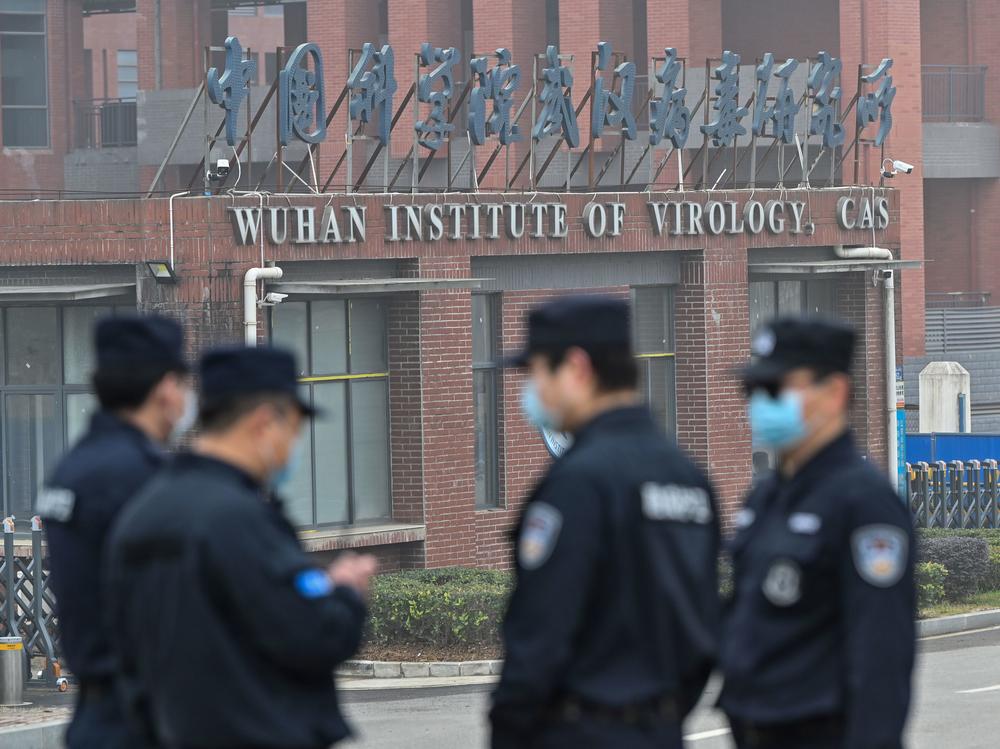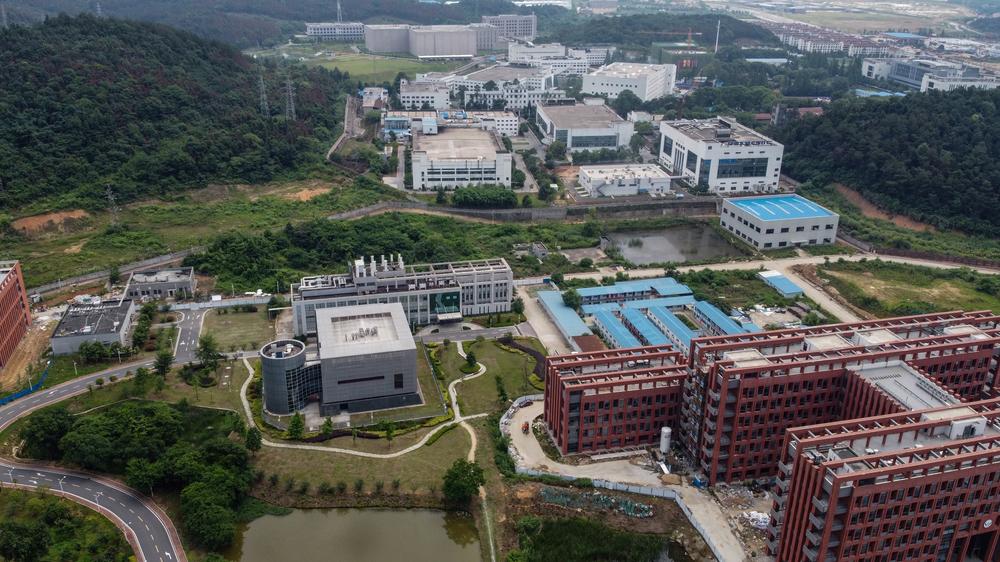Section Branding
Header Content
The Investigation Of The Pandemic's Origins Is At An Impasse
Primary Content
It's still a mystery. How did the pandemic begin?
There is the leading hypothesis among scientists: The virus hopped from an animal — possibly a bat — to a human, or to some other animal, which later spread the disease to humans.
And then there is the lab leak hypothesis: The virus somehow escaped from the Wuhan Institute of Virology.
The debate over the origins is now burning hot, with increasing demand for an international investigation into the possibility of a lab leak. Media reports have fanned speculation, much of it based on circumstantial evidence like the cluster of illnesses among lab workers at the Wuhan lab, first reported on May 23 by The Wall Street Journal but denied by Shi Zhengli, a top scientist at the Wuhan Institute of Virology, in an interview with The New York Times this week.
At the G-7 summit last weekend, the U.S. and its allies called for a "timely, transparent, expert-led and science-based" study of how the virus first emerged. And World Health Organization Director-General Tedros Adhanom Ghebreyesus has reiterated that China should be more forthcoming.
But for all the pressure, meaningful efforts to delve into the matter — and get the WHO investigators back into China to follow up — appear to be stalling.
"We're at an impasse," says Lawrence Gostin, a professor of global health law at Georgetown University and director of the World Health Organization Collaborating Center on National and Global Health Law. "China is implacably opposed to a continued investigation and certainly opposed to one that's fully transparent."
WHO's initial findings: Is that all there is to say?
The first official report from the World Health Organization on the origins of the virus came from an international team of scientists who traveled to Wuhan at the beginning of the year as part of a joint WHO-China investigation. During their 28-day trip, the scientists tried to reconstruct the early moments of the outbreak and the possible pathways for the emergence of the virus.
The final report, titled "WHO-convened Global Study of the Origins of SARS-CoV-2," was issued on March 30 and failed to turn up any conclusive evidence. It did, however, uncover new details about the possible role of livestock farms in southeast Asia and suggested that the Huanan Seafood Wholesale Market in Wuhan may not have been the original source of the outbreak. The authors concluded it was most likely that the virus was introduced to humans by an animal, which acted as an "intermediate host." The possibility that the virus came from a lab was deemed "extremely unlikely."
But there was widespread concern about how the study was conducted.
In a rare move, the WHO's director-general, Tedros, even called out China for not being more transparent and raised concerns that scientists were unable to get unfettered access to "biological samples" and "raw data" that was relevant to the investigation.
"Although the team has concluded that a laboratory leak is the least likely hypothesis, this requires further investigation," he said.
The first report was intended to be the starting point for the joint WHO-China probe, with a second phase of more in-depth studies to follow, based on evidence scientists turned up during their initial trip.
Increasingly, it's unclear what that next phase will look like.
WHO lacks the power
Ultimately, the U.N. agency has few tools at its disposal to make China cooperate.
"WHO doesn't have the power to compel anyone in this regard," the head of the WHO's health emergencies program, Dr. Mike Ryan, told reporters earlier this month, adding that "cooperation" and "consensus" has "worked for us and for our member states for 70 years."
But China has "dragged its feet" on the questions of the origins of the virus all along and sees this ongoing debate over pandemic origins in "stark political terms," so there's no reason to assume that would change now," says Gostin of Georgetown. And that attitude has become more deeply entrenched since speculation over whether the virus leaked from a lab in Wuhan went mainstream, he says.
The World Health Assembly — the decision-making body of the WHO — plans to hold talks in November around the possibility of a new international pandemic treaty. The goal of the treaty would be to make countries more accountable to one another in the event of any future global outbreak by sharing information, technology, resources and data.
In theory, says Gostin, this treaty could also expand the WHO's authority to do "investigations on sovereign territory and to independently verify official state reports."
"I can assure you that China will try to block a really rigorous treaty, but it's still possible that it could go through," he says.
Meanwhile, China is not budging in response to current demands for transparency. During a meeting of WHO nations last month in Geneva, a representative of the government said his country's part of the investigation was complete and scientists should pursue other leads.
China has pushed the idea that the virus came to Wuhan from outside the country, either through frozen food or by some other means. Government officials have also floated unsubstantiated theories that a military lab in the U.S. may have somehow sparked the pandemic.
Pros and cons of pressuring China
Could the situation change? Is it possible that China would rethink its stance and be willing to work with the WHO and the U.S.?
Only under the right conditions, says Yanzhong Huang, senior fellow for global health at the Council on Foreign Relations and professor at Seton Hall University.
"I think China has not shut the door — it has left flexibility," he says. "Instead of publicly accusing China of covering up, quiet diplomacy would be a more constructive approach to handling this issue."
But some experts argue that pursuing a softer, more conciliatory approach amounts to a fool's errand.
"We need to call them out," says Jamie Metzl, a senior fellow at the Atlantic Council. "If China continues to obfuscate and to deny the world the possibility of the comprehensive investigation that we need, it would be entirely appropriate for there to be some penalties, whether economic, trade or otherwise."
"The WHO can ramp up the pressure just by using their moral authority to call out the lack of transparency and the finger-pointing that China is doing back at the United States," says Dr. Amesh Adalja, a senior scholar at the Johns Hopkins Center for Health Security, who adds that the United Nations should also get directly involved in the effort to make China cooperate.
The stuttering international effort has led President Biden to publicly order U.S. intelligence agencies to redouble their own efforts to find the likely origin of the virus and to report back to him by the end of August.
"In the end, the Biden administration's review is likely to be inconclusive and satisfy no one a hundred percent," predicts Juliette Kayyem, a professor at the Harvard Kennedy School and former assistant secretary at the Department of Homeland Security under President Barack Obama.
But Kayyem expects the review at the very least will underscore how the WHO "took China's word far too often" in the early months of the outbreak, for example when it repeated China's contention that the virus did not spread human to human and then waited until March to declare a pandemic.
"We're not going to war with China over this, but what it can do is put pressure on the WHO about how it conducts itself in these kinds of investigations and how China is not to be believed anymore," she says. "If the WHO hasn't learned that now, then we're in big trouble."
Trump standoff with the WHO lingers
The WHO finds itself in a delicate diplomatic situation because it's reliant on its member nations, particularly China, which has grown its influence over the international agency just as the U.S. — under the Trump administration — took a combative approach, even announcing that the U.S. would withdraw from the agency.
"They're walking a very tight line," says Dr. Jennifer Bouey, senior policy researcher and the Tang Chair in China Policy Studies at the RAND Corporation, who notes that Chinese scientists are wary to trust their counterparts in the U.S. after the tumultuous years under President Donald Trump.
"China has been very supportive of WHO," she says, referring to Trump's withdrawal plans.
There may not be anywhere else to look
But even if China did reverse its current stance and allow a team of impartial scientists back into the country, what would they hope to find?
Dr. Daniel Lucey, an expert on infectious disease outbreaks, doesn't believe they would find much that China hasn't already uncovered. He assumes scientists there followed the obvious leads for what could have seeded the initial outbreak in Wuhan — even if they haven't shared information publicly. This includes the recommendation made in the first WHO report to follow the supply chain of animals that could have harbored the virus and brought it to the market.
"It's just not plausible in my mind that [China] just hasn't looked enough," says Lucey, who teaches at Georgetown University and the Dartmouth Geisel School of Medicine. "They would have done it immediately because it was in their medical, public health and national security interests."
But Lucey says there seems to be valuable information that China has withheld about how the virus may have made it into the market and when cases of COVID-19 were first identified.
For example, a peer-reviewed study that was published only this month in the journal Scientific Reports contains extensive details of which live animals were being sold in Wuhan's markets leading up to the first known outbreak of COVID-19. In the study, scientists from China and Canada described animals like minks and raccoon dogs — two examples of mammals known to harbor coronaviruses — being "sold alive, caged, stacked and in poor condition" with most stalls offering butchering services on site.
"We've heard nothing about testing any of these animals — where did all those live animals go when the market was closed? It's just silence," says Lucey, who notes that China's official position has been that neither live mammals nor illegal wildlife were being sold at the Wuhan market.
Another detail that has gained more attention comes from a March 2020 story in the South China Morning Post. The reporter claims to have seen internal government documents showing more than 260 cases of COVID-19 identified in 2019, with the earliest cases tracing back to Nov. 17.
It may be time to look at other leads
Rather than pushing for access to Chinese labs, the WHO should pursue these two pieces of evidence in its ongoing probe and see whether China in return will offer up more details, Lucey says.
"I just don't see any reason China would ever allow a forensic lab investigation," he says. "Even then, if you want to hide something, you can hide it."
Dr. Adalja at Johns Hopkins isn't expecting another on-the-ground investigation will yield much, either — unless China suddenly grants full access to data and samples that could be relevant to the first cases and to personnel who worked at the Wuhan Virology Institute.
Says Adalja: "I'm becoming less and less inclined to think that the traditional epidemiology is going to give us the answer this late in the game."
Copyright 2021 NPR. To see more, visit https://www.npr.org.


